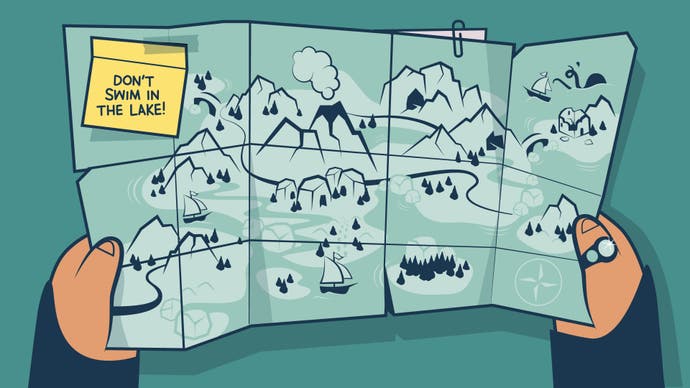Who is qualified to make a world? In search of the magic of maps
"You're travelling with your imagination..."
Shortly after David Gaider was born, his parents bought a set of 1971 encyclopaedias to freeze-frame the world as it was when he entered it. He still remembers the maps they contained: his first atlas. But there are two moments in Gaider's life when a gift of maps leads to adventure. In the second, he's older, and already working at the job we know him best for. He was a lead writer at BioWare.
At the time, BioWare was embarking on a new adventure, creating two brand new games and the universes around them. One was to be science fiction and would become Mass Effect. One was fantasy and would become Dragon Age. That's the game Gaider was working on - or rather, it was the world he would dream up.
Ideas had been swirling about what Dragon Age would be for a few months. The team knew it would be like D&D but would not be actual D&D, because BioWare was sick of licensed games at the time. They knew they were going for Tolkien rather than Conan or Diablo. "We definitely had at least some idea of the kind of RPG this was going to be," Gaider tells me when in a video call. But BioWare didn't have a world, and that's where the second collection of maps comes in. One day, Gaider was handed a historical atlas of Europe and tasked with going away and coming up with a fantasy world for players to explore.
And almost immediately, he sketched a map.
I understand the impulse. Maps have held power over me for as long as I can remember. I can distinctly recall being fascinated by the large shapes of European countries I was colouring in at school. Who lived in these elongated places in the north, and what were they like? This was a curiosity that gave way to obsession when fantasy crashed in, complete with a black and white and red map of a trek to a place called the Lonely Mountain, where a dragon lived. Maybe you know this map yourself.
That love of fantasy in turn became a love of fantasy role-playing games, many of them BioWare's, actually, but many of them online too, like Dark Age of Camelot and World of Warcraft. Games that shaped me. Places I spent a lot of time in. There are maps I can still see when I close my eyes.
But, midway through the journey of life, I wonder: why do maps have such an effect on me, and on us in general? What is it about a map that gives it magical powers to bind us and pull us in? I wanted to know more, and through talking to David Gaider and learning about his creation of the map for Dragon Age, I hoped I might find out.
"Everyone loves a map"
Where better to begin than by asking, "What is a map?" And who better to ask than the curator of antiquarian mapping at the British Library, Tom Harper. "Well," he tells me, slightly taken aback by my bluntness, "people's perception on what a map is changed hugely over time."
We haven't always viewed maps or used them in the same way, apparently. We think of them now as being top-down things, because that perspective has been normalised, but in the 13th or 14th centuries, Harper tells me that maps were more like word diagrams. Matthew Paris drew a famous map of Britain in 1250, "And it's basically just a list of places with a wiggly line drawn around it," as Harper puts it. It's more of a pilgrimage itinerary than a map.
And yet, it was useful at the time, which turns out to be a crucial factor in determining what a map is. All maps have a function, an agenda, a purpose. When the Bible reigned supreme in the western world, and our understanding of the world was shaped by it, maps were filled with religious fancies, like Hereford's Mappa Mundi, with its Garden of Eden and people with no heads. When people started sailing around the world, maps charting the seas of their expanding conception of the planet became the thing. Then, as we in the West began greedily staking a claim on new territories, possessive and political maps took off. "The one thing that has linked the things we associate as maps is that they've always had to be useful," Harper says.
Slowly, fantastical elements were elbowed out as the need for grids and precision came in. It's how we ended up believing, up until very recently, that a map had to be a plan, Harper says. That's what he was taught. "It has to be accurate, it has to show places to the correct scale and proportion, and in relation to each other."
But by those standards, some of the most famous maps I can think of wouldn't exist. Middle-earth would be thrown out, because its geology doesn't make sense - just look at the C-shaped mountains around Mordor! - and the rivers are wrong. "It's absolute bollocks, really," Harper says, albeit very fondly, for he loves the book and he redrew that map countless times as a child, growing up, in order to 'put it right'. He once made the mistake of telling his art history professor how much he liked the book, "And he was absolutely aghast," Harper says. "Aghast."
Attitudes, though, have changed. Fantasy has come out of the Narnia-like closet and into the mainstream, and nowhere is this more apparent than at the British Library, which is where I talk to Harper and to Tanya Kirk, the curator of the Fantasy exhibition that's only just finished there, and is now going on tour to the US. "The Library makes a statement with every choice of exhibition," Harper tells me, "and these are important things: we don't put on exhibitions lightly." I've already written about how validating the Fantasy exhibition was for me.
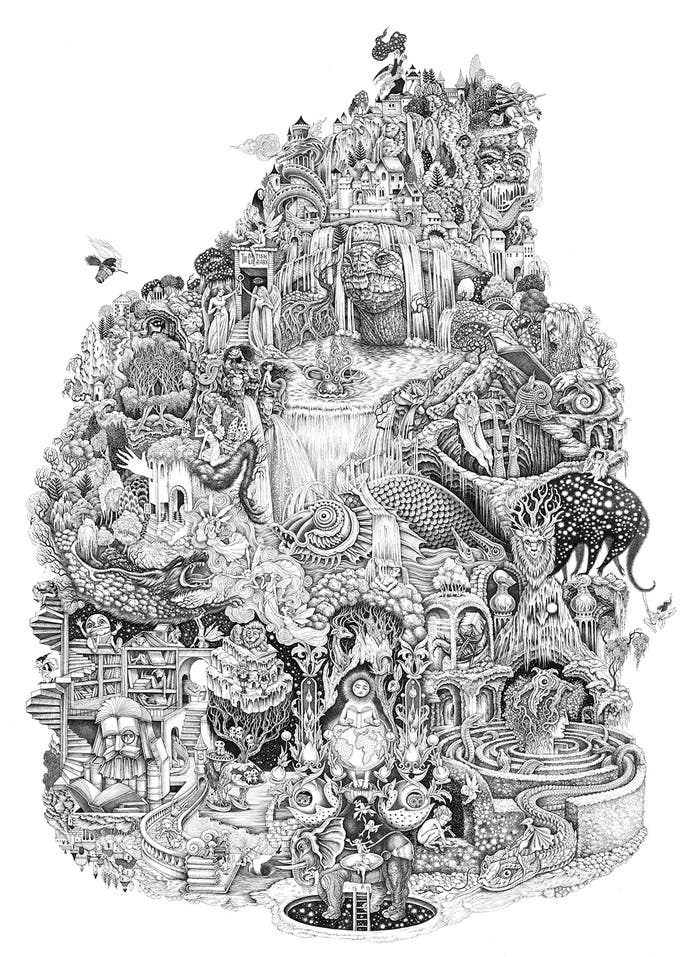
That exhibition opens with a great big map - Bernard Sleigh's Anciente Mappe of Fairyland, created in around 1920 - and fantasy maps feature heavily throughout, in all their forms. Kirk was adamant from the beginning that they would. "A hundred percent," she tells me. "I think they are what a lot of people associate with fantasy, and it's one of the things people love about fantasy. And we know from working here," she adds, "that everyone loves a map, because whenever we do a map exhibition, people go absolutely wild."
But why? Again, just what is it about maps people latch onto? Kirk and Harper have a potential answer for me, or part of one: it's to do with helping us understand ourselves.
"I feel like it's a way of understanding the world," Kirk says. "A lot of the reason why people like fantasy is that it is a different way of understanding the world, and maps play a similar role to that. Fantasy can show us things in a different way, in the same way you might know a place really well, but when you see a map of it, you see a different perspective and you understand how things fit together."
"Personally," Harper adds, "it ties to what I was saying about when people see a map of a place they recognise: they get drawn into it. Maps are important to us because they actually tell us about ourselves, and they enable us to reflect upon who we are and where we belong. Maps are about people; places are about people. I really see that dichotomy between people and places with maps as the agent in helping us understand and explore that.
"It's a subconscious thing as well," he adds. "Of course maps are practical, wayfinding things, and if you ask people why are maps useful, they'll probably say because they help us find our way around.
“But when you're a kid and you're looking through a school atlas and you're getting taken away to these places on the other side of the world, it's not a practical, wayfinding purpose there. You're travelling with your imagination, and in that process, you're finding out more about yourself."
"La la la, I'm going to call this Ferelden!"
Almost immediately, then, David Gaider sketched a map.
In fact, he corrects me, "I sketched a lot of maps." But they were the same map, replicated over and over, because in order for a world to make sense to Gaider, it needed history. "I drew this coastline and then made a bunch of photocopies of it," he says, "and did this series of sketches, like, 'Okay in this era, this is where people lived and where they migrated and created different cultures,' and those cultures changed over time as they got conquered. Much like the book of European maps I had, I was doing it in eras and forming an idea in my mind about how these groups all mingled together."
David Gaider was kind enough to share his original sketches of the Dragon Age world with me, and in them, you can see an emerging flow of history. You can see the spread of the Tevinter Empire as the race of Men lands in the north and then begins to spread out. You can see, in the earliest images, there's still a kingdom of Elves in the forest of Arlathan, nearby. Then, they are forced out by the growing Tevinter Empire, south to the Dales, where we encounter them in the Dragon Age games, subjugated to being a kind of slave race. Tribes give way to kingdoms, and names we're familiar with begin to appear.
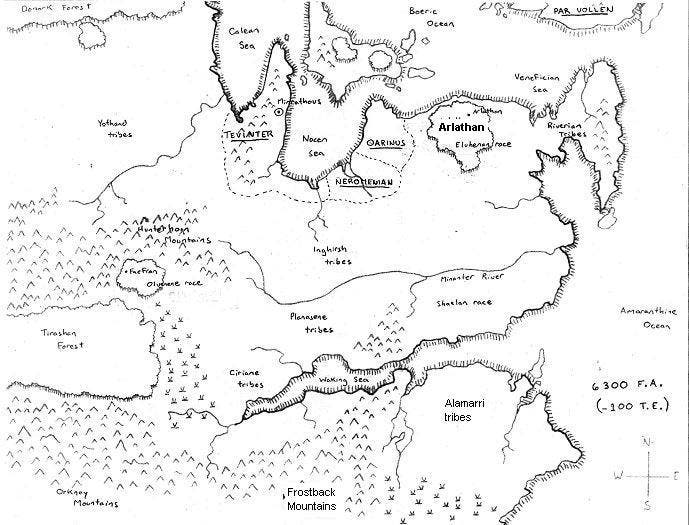
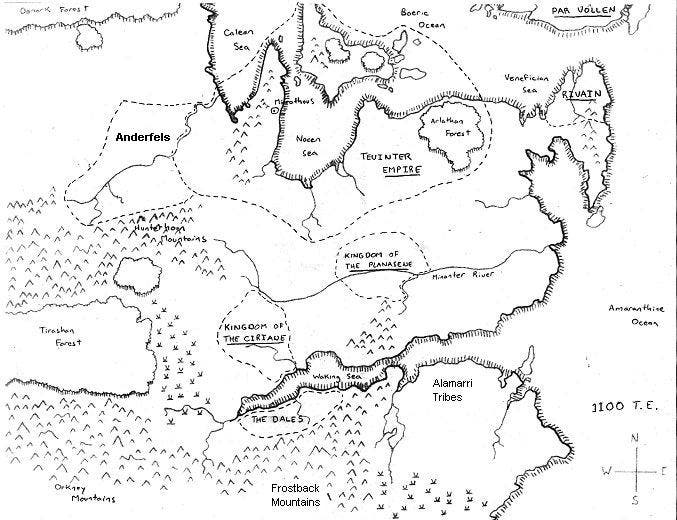
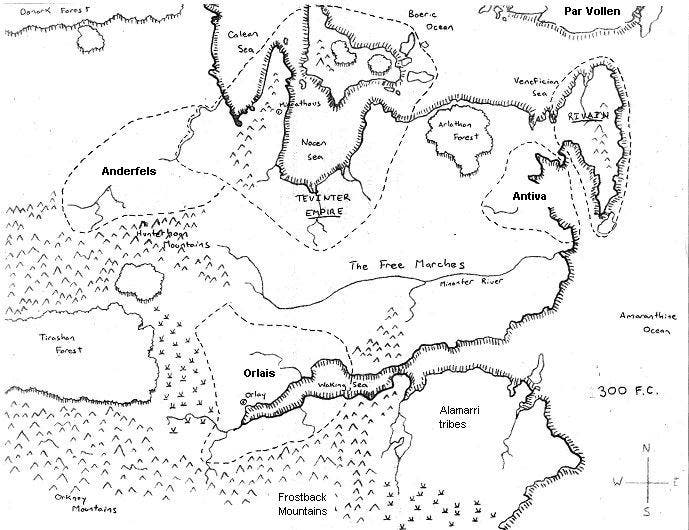
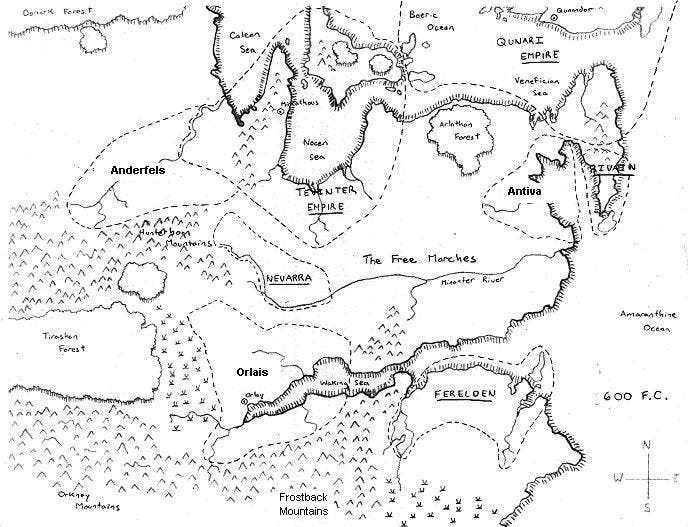

"My feeling on history when it comes to worlds," Gaider says, "is that you need to have a lot of it." Without it, he says a world will feel like a facade. "Sometimes you'll see worlds where they've made only what is needed for their current story, and it's like an old Western set: it feels right, it looks right, but then you slowly get a sense of, 'Oh, there's nothing behind those doors.'"
Before he sat down to draw, Gaider already knew some of the geographical elements he wanted. He knew he wanted a topsy-turvy 'South was cold and North was hot' idea for the continent, to play with people's expectations, and he knew he wanted a large waterway - that he likens to the Mediterranean - carving its way far inland. Today, we know this as the Waking Sea, and it's an incredibly important feature in the Dragon Age games.
Gaider also knew he wanted islands far up in the north, from which an unknown race could invade. "I knew that I wanted an 'other' race that would come along," he says, "which ended up being the Qunari." This is the Qunari that shaped Dragon Age 2, and from which the famous Dragon Age 3 character Iron Bull came.
Intriguingly, Gaider also knew he wanted untouched areas for adventure, like forests and mountains, just in case the game would need them. "I didn't want every place to be so civilised that when it came time for 'we need ruins' or 'we need massive wilderness', we've got nowhere to go because I've civilised the entire thing," he says.
Because remember, the team didn't yet know where the game they were making would be set. That's why so much of the continent you see in the sketches is as yet unused in Dragon Age games - the series hasn't needed all of it by this point. Continents are vast, after all, and realising them in 3D for players to explore is a mighty task. "I guess in my head," Gaider says, "we would be probably either on the north of Ferelden, on what became the Free Marches, or maybe off in the west more towards the Tirashan Forest or the Hunterhorns. That was a very wild area and I was like, 'That's a good place for an adventure to be.'"
Atlas at hand, photocopies in front of him, Gaider set about his work of growing a game world from a bunch of maps, and with not a small amount of trepidation. There was a lot riding on the world after all; it was a far cry from the worlds he'd created and freely abandoned as a teenager. "This is going to form the foundation, ideally, for a lot of games," he says, "and a lot of people are going to do work [on it]. And the trepidation is like, 'I don't know what I'm doing.' I'm essentially the equivalent of a 13-year-old just going, 'La la la, I'm going to call this Ferelden!'
"Who is qualified to make a world?" he asks. "Nobody."
"A perfect map should inspire players and readers from the first glance"
Some people, though, create worlds all of the time. They are the professionals, the fantasy map-makers of the world, and I speak to half a dozen of them while researching this piece. Between them, they're responsible for Collector's Edition maps in Baldur's Gate 3, The Witcher 3, and Diablo 4, as well as huge swathes of Dungeons & Dragons maps, Critical Role maps, fantasy books, and many more. There's a considerable overlap in all of these areas of fantasy, each supporting and fuelling the other. If anyone knows how to create a world, they do.
Brazenly, TikTok map-maker Cody J King - better known as Dungeonmastersdiary - draws directly onto paper in pen, live, and with no pencil marks first. It's part of the hypnotic appeal of what he does. But underneath the apparent simplicity of the worlds that emerge from him is actually a methodical, rather scientific process - a chain-reaction of sorts. King will follow the natural laws of geography to gradually pull a world into existence.
"In drawing something like a fantasy map," he tells me, "it's actually dozens if not hundreds of compositional elements layered upon one another to make a ton of sense, whether that's through geology - having mountains correctly in the right spot, if you are going down the depths of tectonics - and having hydrology operate correctly and rivers flow; having estuaries and riparian zones in the correct places."
If a mountain is the first thing he draws, then, he'll know that there's some tectonic activity going on below it, in order for the mountain to be there. "So I might draw a mountain, and if it's independent, that's probably a volcano; if there's mountains that are in a string or a line, that might be a mountain range. And then from there, I work off and create rivers and river valleys and little things like that," he says.
He's not the only mapper to build a world like that - the more I talk to people, the more I discover that proper geography underpins a lot of the fantasy map-makers' works. "When I'm making my own maps, everything starts with fault lines, tectonic plates, prime meridians and the equator," says Critical Role mapper Deven Rue. It's a process that helps lessen the overwhelming feeling a blank page can create.
But before any of this, another crucial step comes first: communication with a client. Discussion, understanding, immersion in whatever world that's to be made. For Rue, that means working exclusively with Critical Role dungeon master Matt Mercer, who dreams up the group's worlds and campaigns, and likes to keep them top secret and a surprise.
What the client wants depends massively on what a map is being made for. Whether it's a tabletop role-playing game, a video game, a book, they all have different requirements. Authors often supply sketches of worlds they've created to write alongside, to plot their journeys. The stories of JRR Tolkien famously began with a map that his son Christopher would later tidy up.
Typically, TTRPG briefs will offer map-makers the most freedom, because the step-to-step exploration of a world needn't be so specific, and maps are there more to evoke a setting and a theme, which all of the map-makers enjoy doing. Though a slight addendum: this freedom shrinks considerably when mapping Dungeons & Dragons settings that have been around for decades, and are subsequently areas that many people know, and when you're making precise battle maps.
Video game maps also have their restrictions, as they have to reflect, at least broadly, the world players explore, the worlds developers painstakingly create. "Cartographers are never one hundred percent free to do whatever they would like with the final artwork," Francesca Baerald says.
Baerald's one of the most decorated map-makers I speak to. Most notably, she made the sumptuous world maps the Octopath Traveler games open with, but she's also worked on other major video game properties like Warcraft, Diablo, Assassin's Creed, and Greedfall. She's worked in tabletop RPG land, she's worked on fantasy books. She even, as fate would have it, made a version of the Dragon Age world, although long after Gaider had created it.
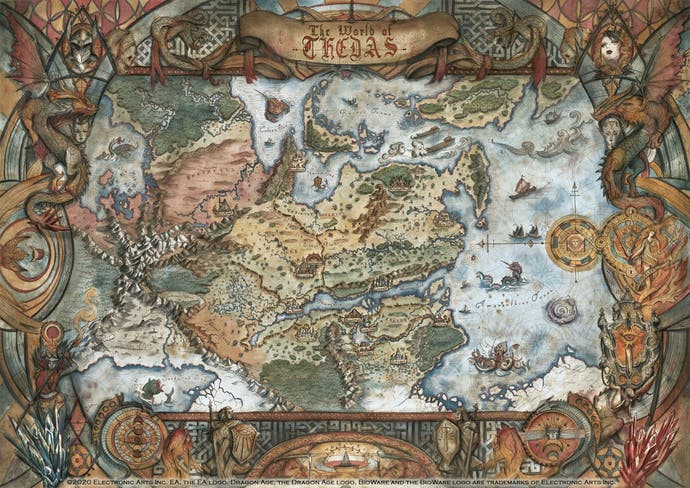
Like King, Baerald creates almost exclusively physically, painting her worlds onto paper using watercolour. She'll first immerse herself in a world, imagining it almost from the perspective of someone living there, then sketch large geometric shapes, before filling them in with specific landmark details. Then, and only then, she'll paint, because revisions after this point are much harder to do. "I believe a perfect map should inspire players and readers from the first glance," she says. "I see maps not as instruments to find directions in a game, but as decorated, welcoming doorways that drag you into the game's world."
Others work differently. One of my favourites is Mike Schley, for the vast amount of work he's done on D&D over the years. Open any D&D book and you'll see his work. His are the top-down, almost Ordnance Survey-like maps, with dinky beds and tables and props, and warmed with colour. What I find so special about his work is how he occupies a middle-ground between form and function, fulfilling plan-like accuracy while also evoking feeling and emotion. He knew he was onto something when he saw "folks taking my maps and importing them onto cheap flat-screen monitors and laying those monitors on their backs on table tops, and using their miniatures on top of that", he tells me.
Unlike Baerald, Schley works digitally, in PhotoShop with a Wacom tablet. But he too draws large to small, eventually getting to the minute details he likes most. "When I zoom in," he says, "I am down in the weeds, exploring that world in my mind's eye as I'm creating it." He's discovering the map while he walks around in it, asking himself questions like, "If these two buildings exist in proximity to one another, how is the grass going to get trampled between these two locations?"
Or in the case of his favourite map (of Hochoch in the Greyhawk setting of D&D), to use an example, "I'm thinking about guys pulling their fishing boats up the shore and parking them at the end of the day, or the folks that live outside of the city walls; like, what the hell do they do when there's armies on the border? Who's the guy that's built this little keep down on the south side of the bend in the river? And the lumbermen that are packing things up onto these barges: how far back into those woods did they have to go yesterday before they could get to trees that hadn't already been felled over the last 20 years?

"How we experience and interact with the world around us is what I try and bring into the process of drawing whatever world I happen to be developing," he adds. "Wherever we're at, whatever continent or whatever world we happen to be existing in, the human condition - things like love and safety and your relationship to your children, and relationship to your neighbours - those all play out from a place that's real. That's what I like to think about, even though I may be drawing a map of someplace that's vastly different to what's right outside my window."
Perhaps the echoes of these thoughts are what we feel when we look at his maps - perhaps that's what pulls me in. But to do so, a map also needs space, Schley says. Space for us to pour our imaginations into. "Leaving that room to breathe is absolutely essential," he tells me. It's also why King says he never names any of the places on his maps, because he wants you to do that. He wants your mind to consciously, or subconsciously, imprint itself upon what it sees.
"Oh, I didn't want it to look like this, exactly"
Some things bother David Gaider about the Dragon Age 1 map, still, and they occurred when artists prettied his sketches without his involvement. "Oh," he said awkwardly when they were presented to him. "I didn't want it to look like this, exactly."
He says they added a lot more rivers and mountains, and flipping between his sketches and the Dragon Age: Origins map, you can see some have moved around, or gained prominence, and places like Redcliffe have shifted. Apparently people would take to the BioWare forums after the game came out to complain about the map's geography. "And I'm like, 'You know what? You got a point,'" Gaider says. This is mostly anger at himself, though, for not doing more about it.
Similarly, he wishes he'd been able to sit down with artists and work out what the rest of the continent you don't see in his sketches looked like, so they didn't have to have "the continent just keeps going..."-like messages at the edge of it. "But to where?" Gaider says.
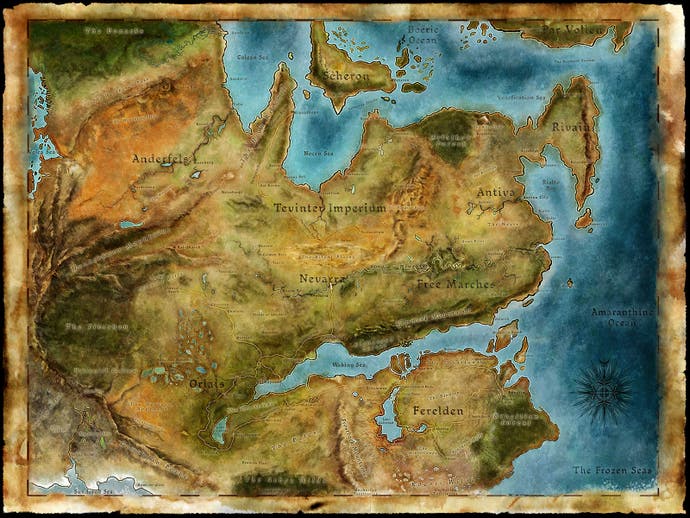
But it speaks to something he's noticed in his decades working in games about artists and writers. "They really speak two different languages," he tells me. They process things differently and they tend to care about different things. There were reams of history and lore written in a "world bible" for the Dragon Age team, but getting artists to read it was another matter. They wanted clear visual cues, not piles of backstory.
Dragon Age: Origins eventually found its setting in Ferelden, the kingdom in the bottom right bulge of the sketches, so it left a huge portion of the sketched world unused, which the team presumed no one would ever see. "We thought that was going to be the only one," he says of Dragon Age: Origins. "That's why when you get to the end of Origins, there's so many epilogues that cast off far into the future, which, if we'd known that we were going to keep going and keep going with history, we wouldn't have said, 'Oh, in fifty and one hundred years, this is going to happen.' I think we would have played our cards a little closer to our chest."

EA apparently found the game very old-fashioned and thought no one wanted turn-based role-playing games like that any more, which of course now seems ridiculous given the success of Baldur's Gate 3. "Baldur's Gate just goes to show how wrong people are when it comes to industry wisdom," Gaider says.
Nevertheless, when Dragon Age 2 eventually was green-lit, the scope of it, and the focus of it, would completely change. With it, BioWare and EA would push towards a console RPG experience that stopped and started less, and had more action-packed combat. And EA only gave BioWare 18 months to make it, so BioWare decided to make a much smaller, more tightly focused game. It seemed like a good idea at the time. "People at BioWare convinced themselves that the fans would be okay - it'll be fine if it's a smaller game," Gaider says. "And I don't know why we thought that was the case, but for a moment there in time, we were like, 'Yeah, sure, it'll be fine.'"
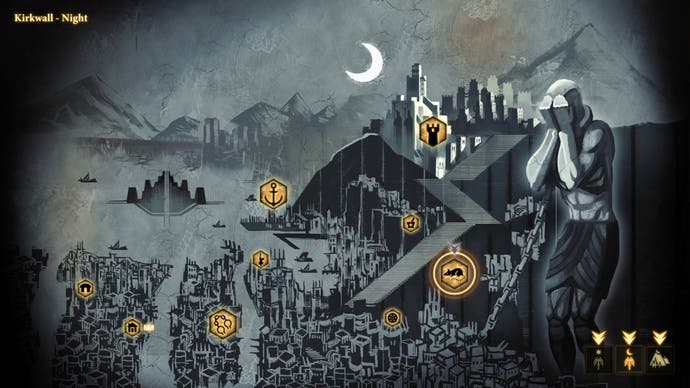
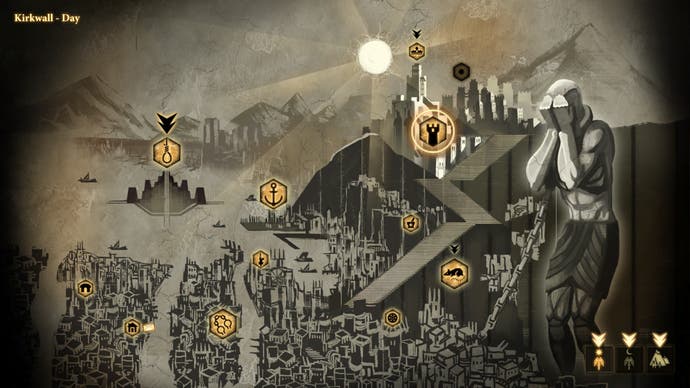
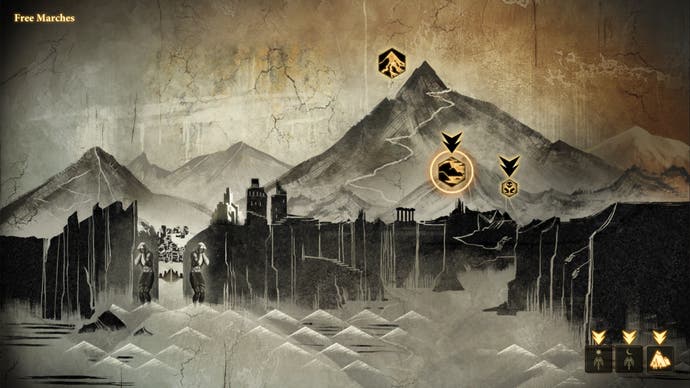
As for the mapping, a tighter focus meant centering on one place rather than a whole region, so the city of Kirkwall on the Waking Sea became the heart of the game, and BioWare developed a time-jumping idea for the game so you could see it at various different points in your character's lifetime, which I still think is really neat. And because there wasn't a large region to explore, the game didn't need a sprawling map, so BioWare turned the map on its side to give Kirkwall some height and majesty instead. It wasn't particularly memorable, but it looked nice.
The game didn't go down well. "Its highs were really high, and its lows were really low," Gaider says now. "It was very unpolished. If it even got six months more polish, I think the reception would have been a lot different." More importantly, it meant everything would need to change again for Dragon Age 3.
"I would revisit this idea that a map is an exciting tool"
Maps used to come with games, and by that I mean they came with the game discs in their boxes. We couldn't ignore them then, or take them for granted. We had to use them to navigate, so we were constantly reminded of them. I still vividly remember racing around the first Grand Theft Auto with the paper map on my lap, trying to find spray shops so I could shake the police. It's why I remember Dark Age of Camelot's map, and Ultima Online's map, because it's all there was. They imprinted themselves on our memories through use, and because they helped us imagine the technologically limited fantasy worlds we were playing in.
As technology improved, though, the worlds gained detail, size and complexity, and they opened up, giving us freedom to roam. In doing so, they now find themselves needing - much like in the real-world - more accurate navigational maps, so maps in thrall to decorative fancy were elbowed out in favour of those shaped by function. Our reliance on maps declined, and as digital sales increased and boxes disappeared, maps in boxes faded away. Today, they're kept alive as collectible extras for Collector's Editions.

But not all games follow today's norms. Andrew Shouldice was spellbound by game manuals and the maps in them as a child, so he tried to recreate the feeling in his game Tunic. Your mission in the game is to collect the pages of a manual, in fact, elevating it to a kind of treasure - "the way that a manual felt like a treasure when I was a kid", he tells me. "Not having it and then having it, and seeing that it's part of this other thing, makes it a little bit more precious and worthy of scrutiny."
Shouldice also tries to make you puzzle over the map in Tunic. He wants it to be a "cognitive exercise", as he calls it; he wants to bring the map from the background into the foreground of play. "If I was to be an old man about it," he says, "I would revisit this idea that a map is an exciting tool."
One game he says does this really well is Elden Ring, which is exciting because it's a blockbuster representation of a map that serves both form and function - it looks to me like an elaborate quilt - and yet it toys with conventions by being rather tricksy. "It lies to you at least a couple times," Shouldice says. It's smaller than the actual world, he says, and missing one zone entirely at the beginning. It's also missing information and it has overlapping scenery, which obscures details underneath. "So you get this exciting, revelatory moment where you're like, 'Oh a map! Cool, great. I'll just use that to figure out where I'm going,'" he says. "And you realise it's maybe an unreliable narrator or it has incomplete information. And then you realise, 'Oh, wait, this is a cognitive exercise, this is really exciting.'"
Perspectives
In Dragon Age: Inquisition, the third game in the series, the map plays a starring role. It's built into the game world specifically so you and your Inquisition advisors can gather around it and push pieces about as you choose where to go next.
Thematically, this fits neatly with the theme of running an organisation like the Inquisition, but the map was also required to cover a lot of ground. One thing BioWare knew the moment it started making the game was that it needed to be bigger than DA2. This time, the game would spread across areas of Ferelden we hadn't been to as well as some we had; up to Kirkwall and into surrounding Free Marches, and then west to the city of Orlais and onwards until it reached past the Waking Sea and arid desert land.
But the sense of scale was an illusion. Dragon Age: Inquisition wasn't a continuous, open world, but a fragmented one, made up of a few open-world-like zones, some small parts of cities, and many 'you can't actually explore there, but you can read about it' text-window interactions. Again, this was Gaider's idea, to give the game "a feeling of breadth" without needing the art department to render it all in 3D.
By the time Inquisition came out in 2014, the world of Thedas - the name an amalgamation of "the" and "Dragon Age Setting" by the way - had been reinterpreted for three games and touched by many pairs of hands. Gaider's writing team had plugged the holes he, as a single writer, couldn't fill, and the art team had shown us what the world looked like. There was even, fittingly, a Dragon Age encyclopaedia released, compiling the teetering piles of lore and backstory, and maps and imagery that BioWare created for it. People were now joining the team who were already fans of the series. This was no longer an imaginary world; Thedas felt real. And perhaps it no longer needed Gaider to steer it.

So Gaider left BioWare in 2016, having worked there for 17 years, most of it spent on Dragon Age. Really, he'd had enough of wizards and demons, and Anthem wasn't the tonic he sought. Eventually, he'd move all the way from Canada to Australia for a fresh start, where he'd start Summerfall Studios and make a role-playing musical called Stray Gods, which was released last year. That game, incidentally, only featured a small map for travelling between city locations. Today, he awaits the arrival of a new Dragon Age game - Dragon Age: Dreadwolf - like the rest of us, having had no direct input.
It's an anxious wait, as you can imagine. "I was Mr Dragon Age for ten years," he says, "so there is a certain amount of attachment. I'm not sure how I will feel when Dragon Age 4 comes out. I have a hard time believing that if I play it, I won't spend a lot of the time second guessing any choices I see, like, 'Oh, hmm, I wouldn't have done that.' What if they bring back some characters that I wrote? They're going to Tevinter so what if Dorian's there? Gah! I don't know; I am of two minds as to whether or not I will even play it."
It makes me wonder about these people who create worlds, who draw them into existence - whether that's in a preliminary sketch or a lavish piece of artwork - and whether there's always a point where success comes with the consequence of ceding control. Had Gaider kept the world of Dragon Age to himself, a photocopied map, folded and stuffed in a back pocket, we'd never have played it. And had millions of people not played and enjoyed it, I wouldn't be writing about it now and have that feeling when I look at an image of one of Gaider's photocopies, that I'm in the presence of something special, something powerful.
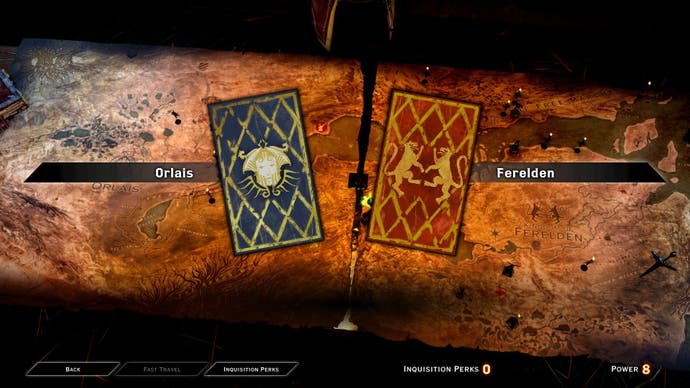
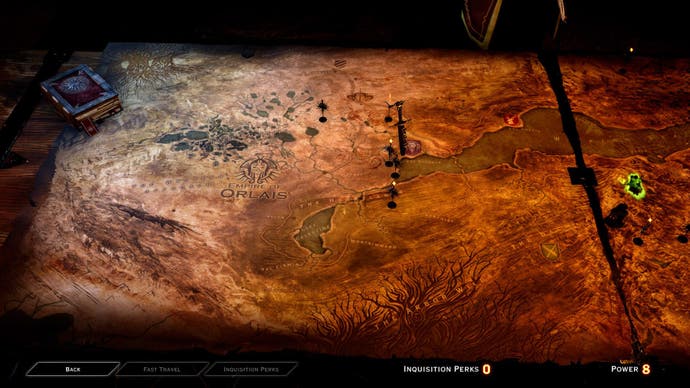
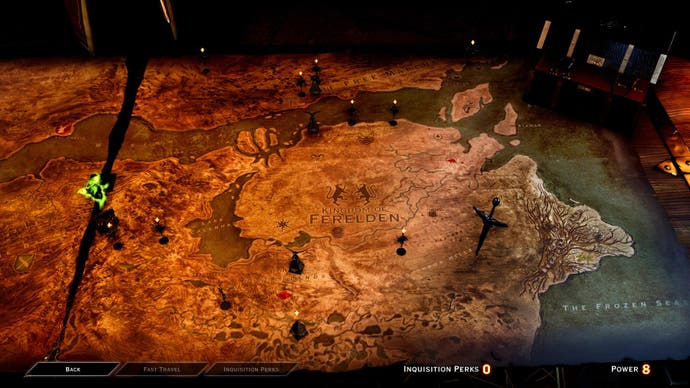
But it's no longer Gaider's map, and no longer Gaider's world. It's all of ours. And that thought brings me all the way back where I began with this, and my mission to understand what it is about maps that appeals so strongly to us. What have I learned from all that I've heard?
For Gaider, maps are snapshots of history, photocopied slideshows explaining how places came to be. And of course they are, because he was thinking about Dragon Age when he started in on maps, which meant that he was thinking about geography, sure, but also the passing of time, and the way the latter affects the former.
For Andrew Shouldice, meanwhile, maps are cognitive treats, little pictorial puzzles to wonder over and wander into, as we try to find our way. And of course he thinks like this, because Tunic, the game that most recently set him thinking about maps, is one big puzzle, one big cognitive treat.
It goes onwards, outwards. For Tom Harper, maps are more like self-portraits, reflecting our lives and experiences back at us. Francesca Baerald calls them "time-travelling photos", that adapt depending on whether we're yet to have an adventure somewhere, currently having an adventure somewhere, or remembering an adventure somewhere, and I like that. Maps are different things to different people.
That didn't initially seem like the answer I hoped for when I set out. And yet, looked at from a different way, I think maybe it is. Perspectives: that's what I'm hearing about here. That's what I'm hearing about from everyone. It's all something to do with the way maps show us different perspectives on different worlds. It's a reminder that we each think about things in our own way, and it takes something new, something different, to change that, to prod us out of our set patterns of thinking and working through things. Maybe this is what maps do. They show us a perspective, but they also remind us that many other perspectives are always possible, so why opt for the same one, or the same handful even?
Listen: think about what it was like for people to see the world from above for the first time; it's not natural, unless you're a bird. Yet suddenly we could see beyond the horizon, beyond mountains, beyond seas. Our tiny viewpoint was replaced with something panoramic. Again: these different perspectives on the world changed our own perspectives, and perhaps prodded us to think about even more perspectives we might adopt.
From word maps to biblical maps, to sea-faring maps with sea monsters on: maps have always been, and probably always will be, about perspective. This is why they continue to tell us as much about their makers and their worlds as they do the worlds they depict. There's much more to a map than we see, and there, I think, we find an invisible bond that connects us: a shared kind of consciousness. To look at a map is to see another person looking at a map, and wonder about the way they see the world, or the way they once saw the world. And we could all do with a bit more wonder.
A huge thank you to all the people who spoke to me for this piece. Thank you: David Gaider, Tanya Kirk, Tom Harper, Francesca Baerald, Mike Schley, Deven Rue, Cody J King, Damien Mammoliti, Marc Moureau, Andrew Shouldice, and Konstantinos Dimopolous. Please take a look at their wonderful work!
